Family Presence During Resuscitation: An Evidence-Based Analysis
VerifiedAdded on 2023/04/03
|7
|1452
|241
Essay
AI Summary
This essay addresses the complex issue of whether family members should be present during patient resuscitation. The author begins by outlining the arguments for and against family presence, including the potential for emotional support and closure versus the potential for obstruction and emotional distress. The essay reviews relevant literature, examining the impact on both patients and healthcare providers. The author presents evidence from various studies, considering ethical implications, patient rights, and the impact on resuscitation effectiveness. The essay concludes by arguing against family presence, citing potential interference with the resuscitation process, violations of patient confidentiality, and increased risk of legal issues. The author suggests the need for a designated staff member to counsel families during the process. Overall, the essay provides a comprehensive overview of the debate, integrating research findings and ethical considerations to inform clinical decision-making.
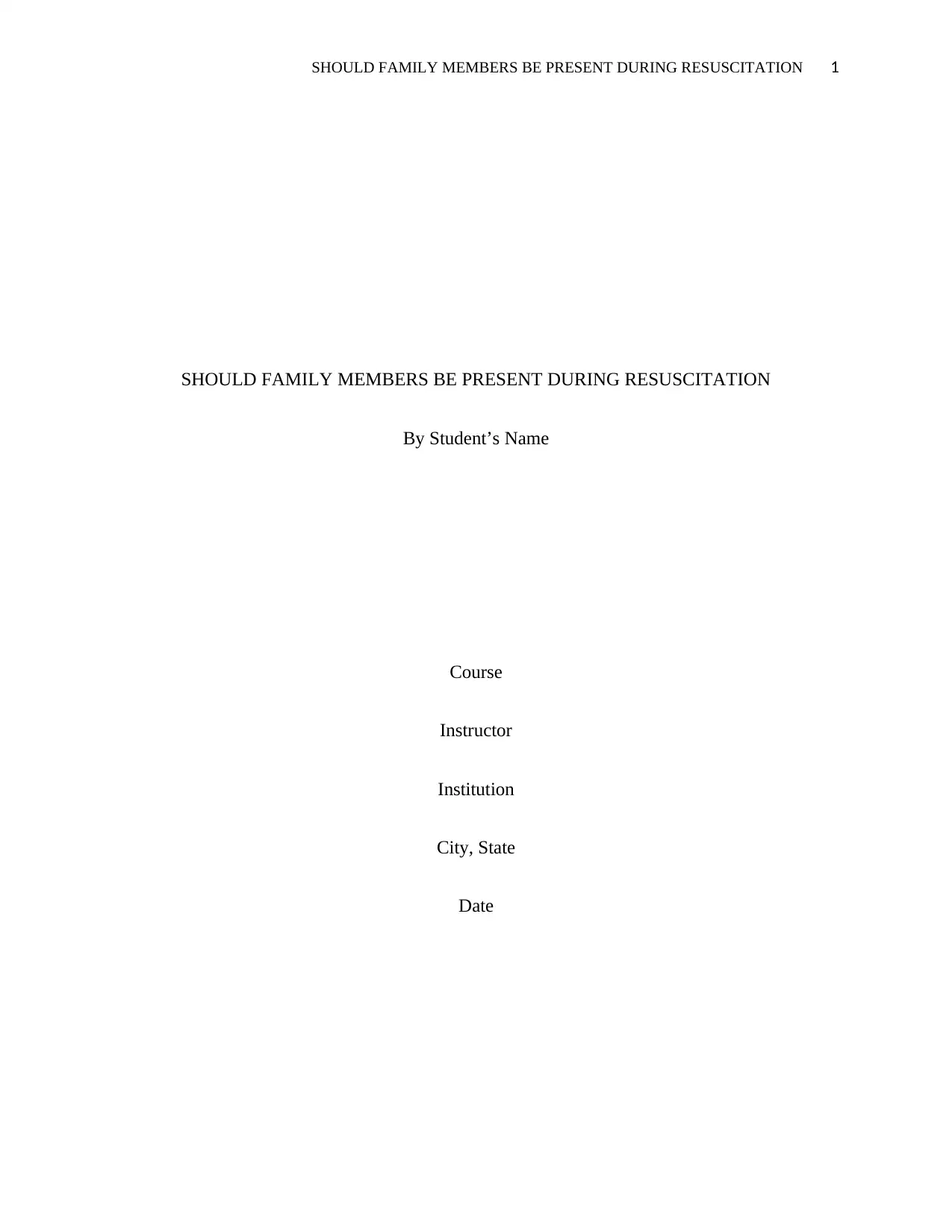
SHOULD FAMILY MEMBERS BE PRESENT DURING RESUSCITATION 1
SHOULD FAMILY MEMBERS BE PRESENT DURING RESUSCITATION
By Student’s Name
Course
Instructor
Institution
City, State
Date
SHOULD FAMILY MEMBERS BE PRESENT DURING RESUSCITATION
By Student’s Name
Course
Instructor
Institution
City, State
Date
Paraphrase This Document
Need a fresh take? Get an instant paraphrase of this document with our AI Paraphraser
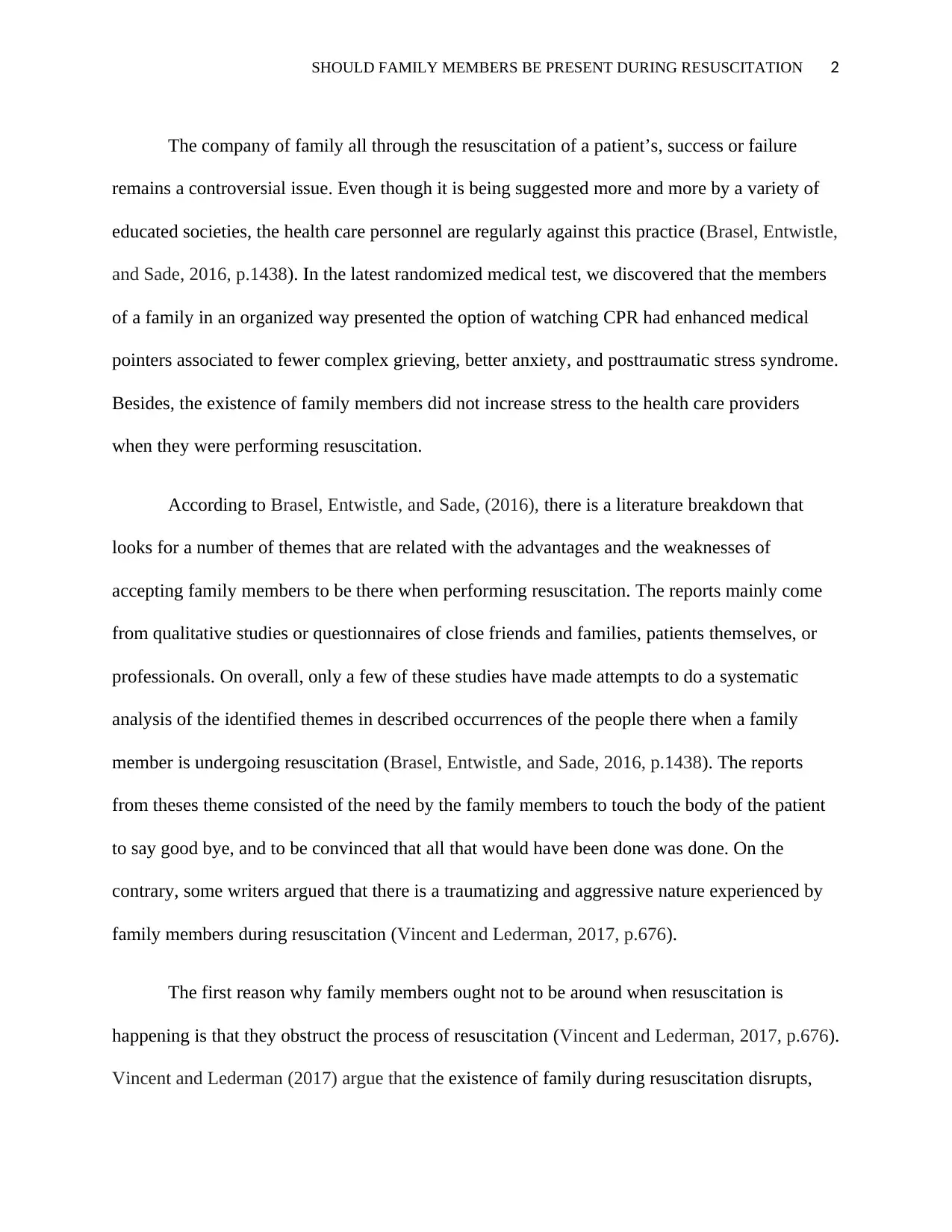
SHOULD FAMILY MEMBERS BE PRESENT DURING RESUSCITATION 2
The company of family all through the resuscitation of a patient’s, success or failure
remains a controversial issue. Even though it is being suggested more and more by a variety of
educated societies, the health care personnel are regularly against this practice (Brasel, Entwistle,
and Sade, 2016, p.1438). In the latest randomized medical test, we discovered that the members
of a family in an organized way presented the option of watching CPR had enhanced medical
pointers associated to fewer complex grieving, better anxiety, and posttraumatic stress syndrome.
Besides, the existence of family members did not increase stress to the health care providers
when they were performing resuscitation.
According to Brasel, Entwistle, and Sade, (2016), there is a literature breakdown that
looks for a number of themes that are related with the advantages and the weaknesses of
accepting family members to be there when performing resuscitation. The reports mainly come
from qualitative studies or questionnaires of close friends and families, patients themselves, or
professionals. On overall, only a few of these studies have made attempts to do a systematic
analysis of the identified themes in described occurrences of the people there when a family
member is undergoing resuscitation (Brasel, Entwistle, and Sade, 2016, p.1438). The reports
from theses theme consisted of the need by the family members to touch the body of the patient
to say good bye, and to be convinced that all that would have been done was done. On the
contrary, some writers argued that there is a traumatizing and aggressive nature experienced by
family members during resuscitation (Vincent and Lederman, 2017, p.676).
The first reason why family members ought not to be around when resuscitation is
happening is that they obstruct the process of resuscitation (Vincent and Lederman, 2017, p.676).
Vincent and Lederman (2017) argue that the existence of family during resuscitation disrupts,
The company of family all through the resuscitation of a patient’s, success or failure
remains a controversial issue. Even though it is being suggested more and more by a variety of
educated societies, the health care personnel are regularly against this practice (Brasel, Entwistle,
and Sade, 2016, p.1438). In the latest randomized medical test, we discovered that the members
of a family in an organized way presented the option of watching CPR had enhanced medical
pointers associated to fewer complex grieving, better anxiety, and posttraumatic stress syndrome.
Besides, the existence of family members did not increase stress to the health care providers
when they were performing resuscitation.
According to Brasel, Entwistle, and Sade, (2016), there is a literature breakdown that
looks for a number of themes that are related with the advantages and the weaknesses of
accepting family members to be there when performing resuscitation. The reports mainly come
from qualitative studies or questionnaires of close friends and families, patients themselves, or
professionals. On overall, only a few of these studies have made attempts to do a systematic
analysis of the identified themes in described occurrences of the people there when a family
member is undergoing resuscitation (Brasel, Entwistle, and Sade, 2016, p.1438). The reports
from theses theme consisted of the need by the family members to touch the body of the patient
to say good bye, and to be convinced that all that would have been done was done. On the
contrary, some writers argued that there is a traumatizing and aggressive nature experienced by
family members during resuscitation (Vincent and Lederman, 2017, p.676).
The first reason why family members ought not to be around when resuscitation is
happening is that they obstruct the process of resuscitation (Vincent and Lederman, 2017, p.676).
Vincent and Lederman (2017) argue that the existence of family during resuscitation disrupts,
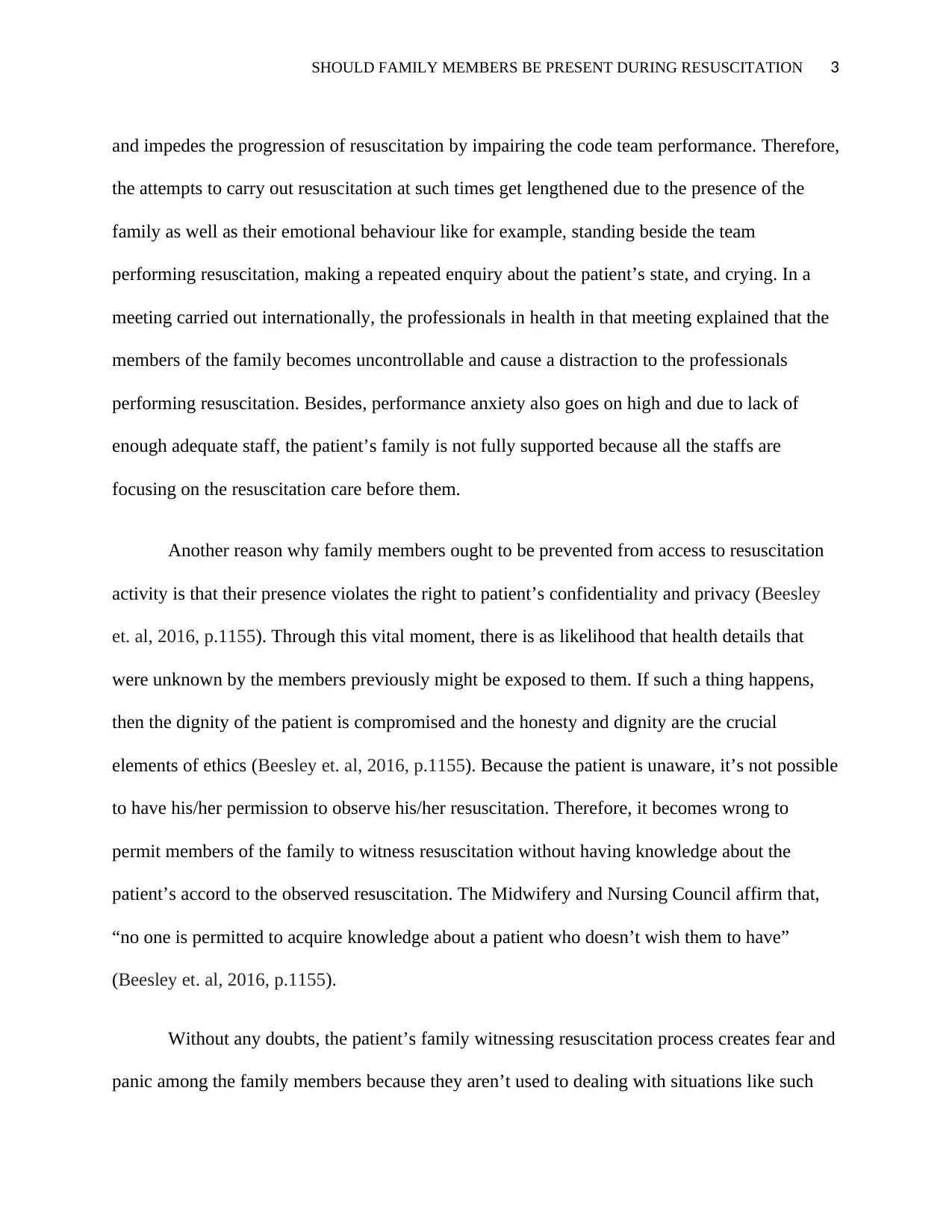
SHOULD FAMILY MEMBERS BE PRESENT DURING RESUSCITATION 3
and impedes the progression of resuscitation by impairing the code team performance. Therefore,
the attempts to carry out resuscitation at such times get lengthened due to the presence of the
family as well as their emotional behaviour like for example, standing beside the team
performing resuscitation, making a repeated enquiry about the patient’s state, and crying. In a
meeting carried out internationally, the professionals in health in that meeting explained that the
members of the family becomes uncontrollable and cause a distraction to the professionals
performing resuscitation. Besides, performance anxiety also goes on high and due to lack of
enough adequate staff, the patient’s family is not fully supported because all the staffs are
focusing on the resuscitation care before them.
Another reason why family members ought to be prevented from access to resuscitation
activity is that their presence violates the right to patient’s confidentiality and privacy (Beesley
et. al, 2016, p.1155). Through this vital moment, there is as likelihood that health details that
were unknown by the members previously might be exposed to them. If such a thing happens,
then the dignity of the patient is compromised and the honesty and dignity are the crucial
elements of ethics (Beesley et. al, 2016, p.1155). Because the patient is unaware, it’s not possible
to have his/her permission to observe his/her resuscitation. Therefore, it becomes wrong to
permit members of the family to witness resuscitation without having knowledge about the
patient’s accord to the observed resuscitation. The Midwifery and Nursing Council affirm that,
“no one is permitted to acquire knowledge about a patient who doesn’t wish them to have”
(Beesley et. al, 2016, p.1155).
Without any doubts, the patient’s family witnessing resuscitation process creates fear and
panic among the family members because they aren’t used to dealing with situations like such
and impedes the progression of resuscitation by impairing the code team performance. Therefore,
the attempts to carry out resuscitation at such times get lengthened due to the presence of the
family as well as their emotional behaviour like for example, standing beside the team
performing resuscitation, making a repeated enquiry about the patient’s state, and crying. In a
meeting carried out internationally, the professionals in health in that meeting explained that the
members of the family becomes uncontrollable and cause a distraction to the professionals
performing resuscitation. Besides, performance anxiety also goes on high and due to lack of
enough adequate staff, the patient’s family is not fully supported because all the staffs are
focusing on the resuscitation care before them.
Another reason why family members ought to be prevented from access to resuscitation
activity is that their presence violates the right to patient’s confidentiality and privacy (Beesley
et. al, 2016, p.1155). Through this vital moment, there is as likelihood that health details that
were unknown by the members previously might be exposed to them. If such a thing happens,
then the dignity of the patient is compromised and the honesty and dignity are the crucial
elements of ethics (Beesley et. al, 2016, p.1155). Because the patient is unaware, it’s not possible
to have his/her permission to observe his/her resuscitation. Therefore, it becomes wrong to
permit members of the family to witness resuscitation without having knowledge about the
patient’s accord to the observed resuscitation. The Midwifery and Nursing Council affirm that,
“no one is permitted to acquire knowledge about a patient who doesn’t wish them to have”
(Beesley et. al, 2016, p.1155).
Without any doubts, the patient’s family witnessing resuscitation process creates fear and
panic among the family members because they aren’t used to dealing with situations like such
⊘ This is a preview!⊘
Do you want full access?
Subscribe today to unlock all pages.

Trusted by 1+ million students worldwide
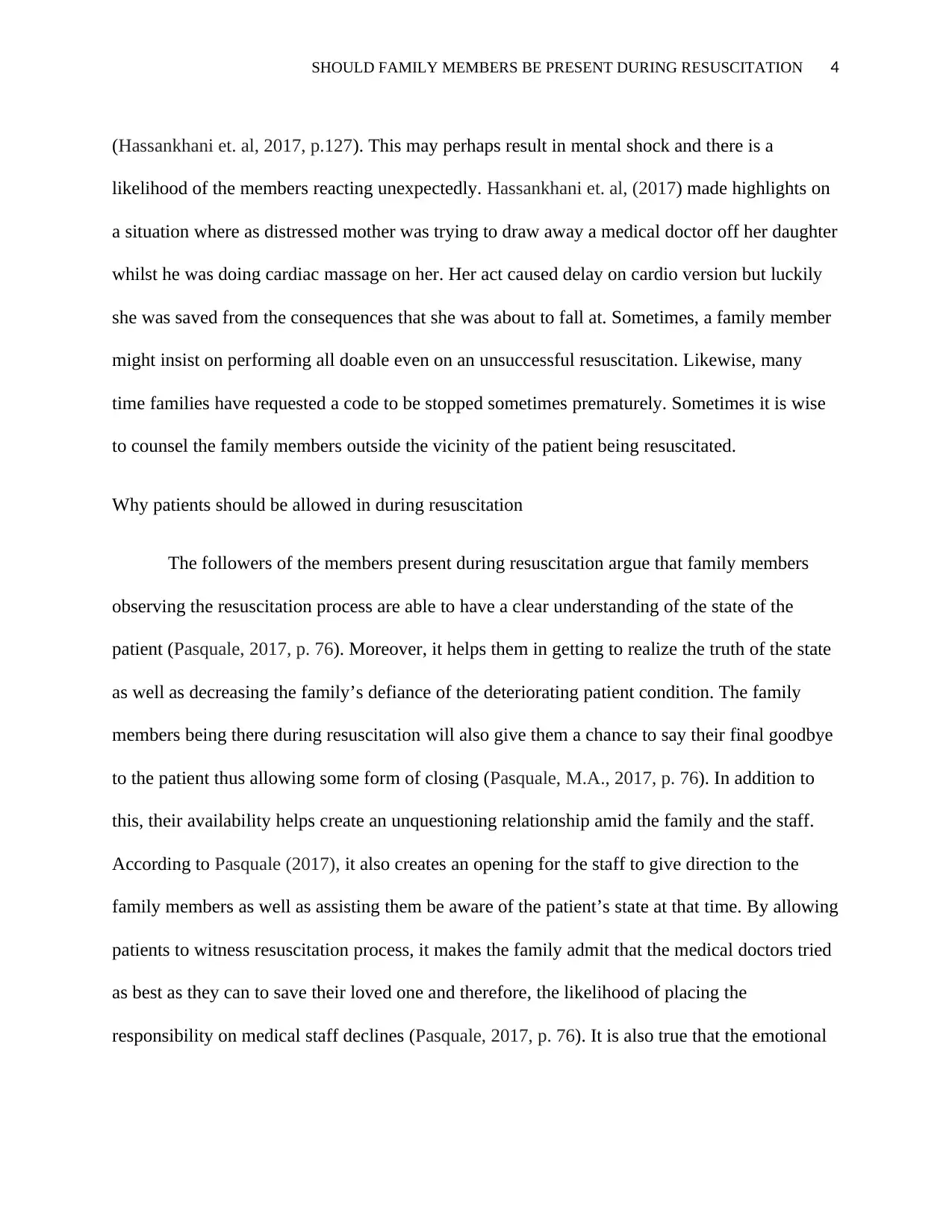
SHOULD FAMILY MEMBERS BE PRESENT DURING RESUSCITATION 4
(Hassankhani et. al, 2017, p.127). This may perhaps result in mental shock and there is a
likelihood of the members reacting unexpectedly. Hassankhani et. al, (2017) made highlights on
a situation where as distressed mother was trying to draw away a medical doctor off her daughter
whilst he was doing cardiac massage on her. Her act caused delay on cardio version but luckily
she was saved from the consequences that she was about to fall at. Sometimes, a family member
might insist on performing all doable even on an unsuccessful resuscitation. Likewise, many
time families have requested a code to be stopped sometimes prematurely. Sometimes it is wise
to counsel the family members outside the vicinity of the patient being resuscitated.
Why patients should be allowed in during resuscitation
The followers of the members present during resuscitation argue that family members
observing the resuscitation process are able to have a clear understanding of the state of the
patient (Pasquale, 2017, p. 76). Moreover, it helps them in getting to realize the truth of the state
as well as decreasing the family’s defiance of the deteriorating patient condition. The family
members being there during resuscitation will also give them a chance to say their final goodbye
to the patient thus allowing some form of closing (Pasquale, M.A., 2017, p. 76). In addition to
this, their availability helps create an unquestioning relationship amid the family and the staff.
According to Pasquale (2017), it also creates an opening for the staff to give direction to the
family members as well as assisting them be aware of the patient’s state at that time. By allowing
patients to witness resuscitation process, it makes the family admit that the medical doctors tried
as best as they can to save their loved one and therefore, the likelihood of placing the
responsibility on medical staff declines (Pasquale, 2017, p. 76). It is also true that the emotional
(Hassankhani et. al, 2017, p.127). This may perhaps result in mental shock and there is a
likelihood of the members reacting unexpectedly. Hassankhani et. al, (2017) made highlights on
a situation where as distressed mother was trying to draw away a medical doctor off her daughter
whilst he was doing cardiac massage on her. Her act caused delay on cardio version but luckily
she was saved from the consequences that she was about to fall at. Sometimes, a family member
might insist on performing all doable even on an unsuccessful resuscitation. Likewise, many
time families have requested a code to be stopped sometimes prematurely. Sometimes it is wise
to counsel the family members outside the vicinity of the patient being resuscitated.
Why patients should be allowed in during resuscitation
The followers of the members present during resuscitation argue that family members
observing the resuscitation process are able to have a clear understanding of the state of the
patient (Pasquale, 2017, p. 76). Moreover, it helps them in getting to realize the truth of the state
as well as decreasing the family’s defiance of the deteriorating patient condition. The family
members being there during resuscitation will also give them a chance to say their final goodbye
to the patient thus allowing some form of closing (Pasquale, M.A., 2017, p. 76). In addition to
this, their availability helps create an unquestioning relationship amid the family and the staff.
According to Pasquale (2017), it also creates an opening for the staff to give direction to the
family members as well as assisting them be aware of the patient’s state at that time. By allowing
patients to witness resuscitation process, it makes the family admit that the medical doctors tried
as best as they can to save their loved one and therefore, the likelihood of placing the
responsibility on medical staff declines (Pasquale, 2017, p. 76). It is also true that the emotional
Paraphrase This Document
Need a fresh take? Get an instant paraphrase of this document with our AI Paraphraser
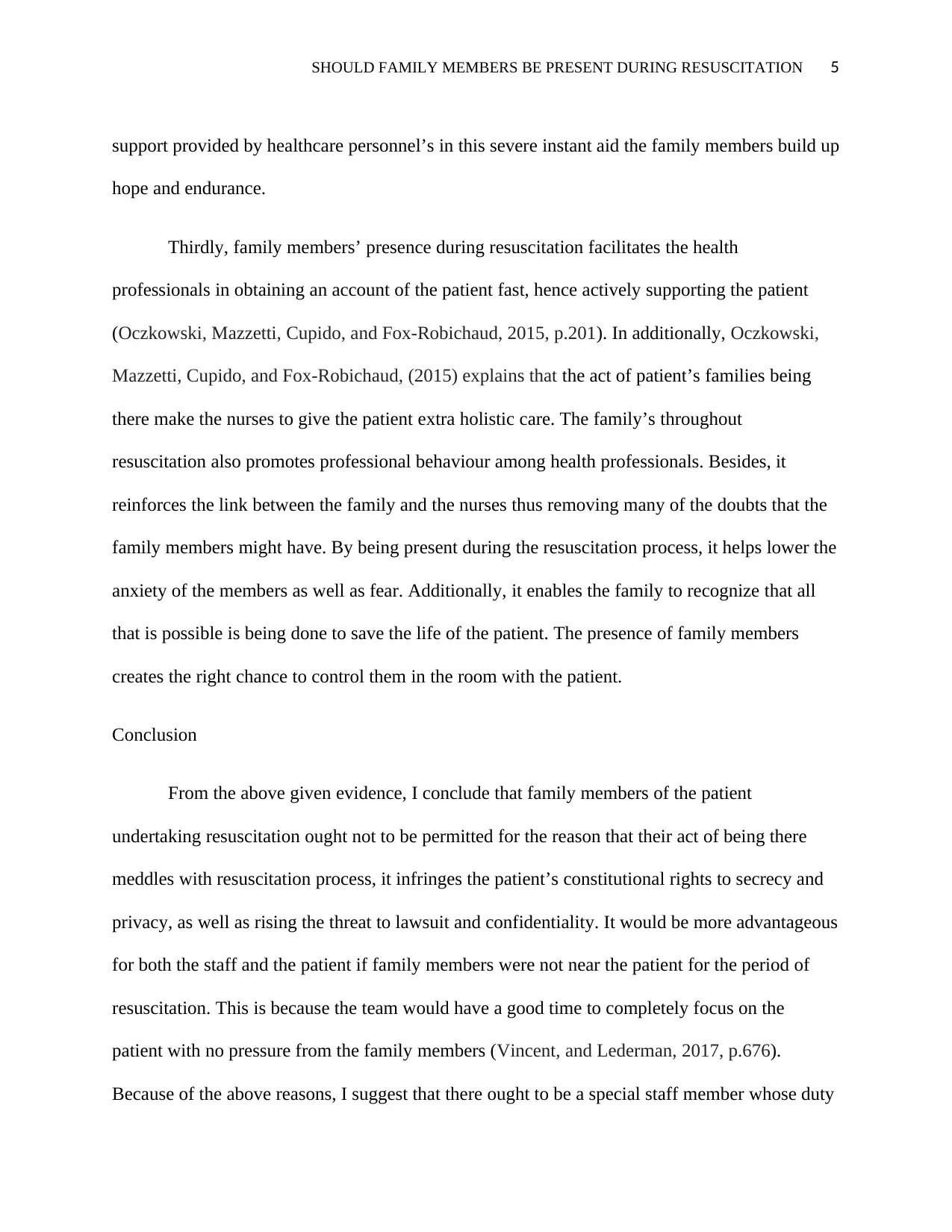
SHOULD FAMILY MEMBERS BE PRESENT DURING RESUSCITATION 5
support provided by healthcare personnel’s in this severe instant aid the family members build up
hope and endurance.
Thirdly, family members’ presence during resuscitation facilitates the health
professionals in obtaining an account of the patient fast, hence actively supporting the patient
(Oczkowski, Mazzetti, Cupido, and Fox-Robichaud, 2015, p.201). In additionally, Oczkowski,
Mazzetti, Cupido, and Fox-Robichaud, (2015) explains that the act of patient’s families being
there make the nurses to give the patient extra holistic care. The family’s throughout
resuscitation also promotes professional behaviour among health professionals. Besides, it
reinforces the link between the family and the nurses thus removing many of the doubts that the
family members might have. By being present during the resuscitation process, it helps lower the
anxiety of the members as well as fear. Additionally, it enables the family to recognize that all
that is possible is being done to save the life of the patient. The presence of family members
creates the right chance to control them in the room with the patient.
Conclusion
From the above given evidence, I conclude that family members of the patient
undertaking resuscitation ought not to be permitted for the reason that their act of being there
meddles with resuscitation process, it infringes the patient’s constitutional rights to secrecy and
privacy, as well as rising the threat to lawsuit and confidentiality. It would be more advantageous
for both the staff and the patient if family members were not near the patient for the period of
resuscitation. This is because the team would have a good time to completely focus on the
patient with no pressure from the family members (Vincent, and Lederman, 2017, p.676).
Because of the above reasons, I suggest that there ought to be a special staff member whose duty
support provided by healthcare personnel’s in this severe instant aid the family members build up
hope and endurance.
Thirdly, family members’ presence during resuscitation facilitates the health
professionals in obtaining an account of the patient fast, hence actively supporting the patient
(Oczkowski, Mazzetti, Cupido, and Fox-Robichaud, 2015, p.201). In additionally, Oczkowski,
Mazzetti, Cupido, and Fox-Robichaud, (2015) explains that the act of patient’s families being
there make the nurses to give the patient extra holistic care. The family’s throughout
resuscitation also promotes professional behaviour among health professionals. Besides, it
reinforces the link between the family and the nurses thus removing many of the doubts that the
family members might have. By being present during the resuscitation process, it helps lower the
anxiety of the members as well as fear. Additionally, it enables the family to recognize that all
that is possible is being done to save the life of the patient. The presence of family members
creates the right chance to control them in the room with the patient.
Conclusion
From the above given evidence, I conclude that family members of the patient
undertaking resuscitation ought not to be permitted for the reason that their act of being there
meddles with resuscitation process, it infringes the patient’s constitutional rights to secrecy and
privacy, as well as rising the threat to lawsuit and confidentiality. It would be more advantageous
for both the staff and the patient if family members were not near the patient for the period of
resuscitation. This is because the team would have a good time to completely focus on the
patient with no pressure from the family members (Vincent, and Lederman, 2017, p.676).
Because of the above reasons, I suggest that there ought to be a special staff member whose duty
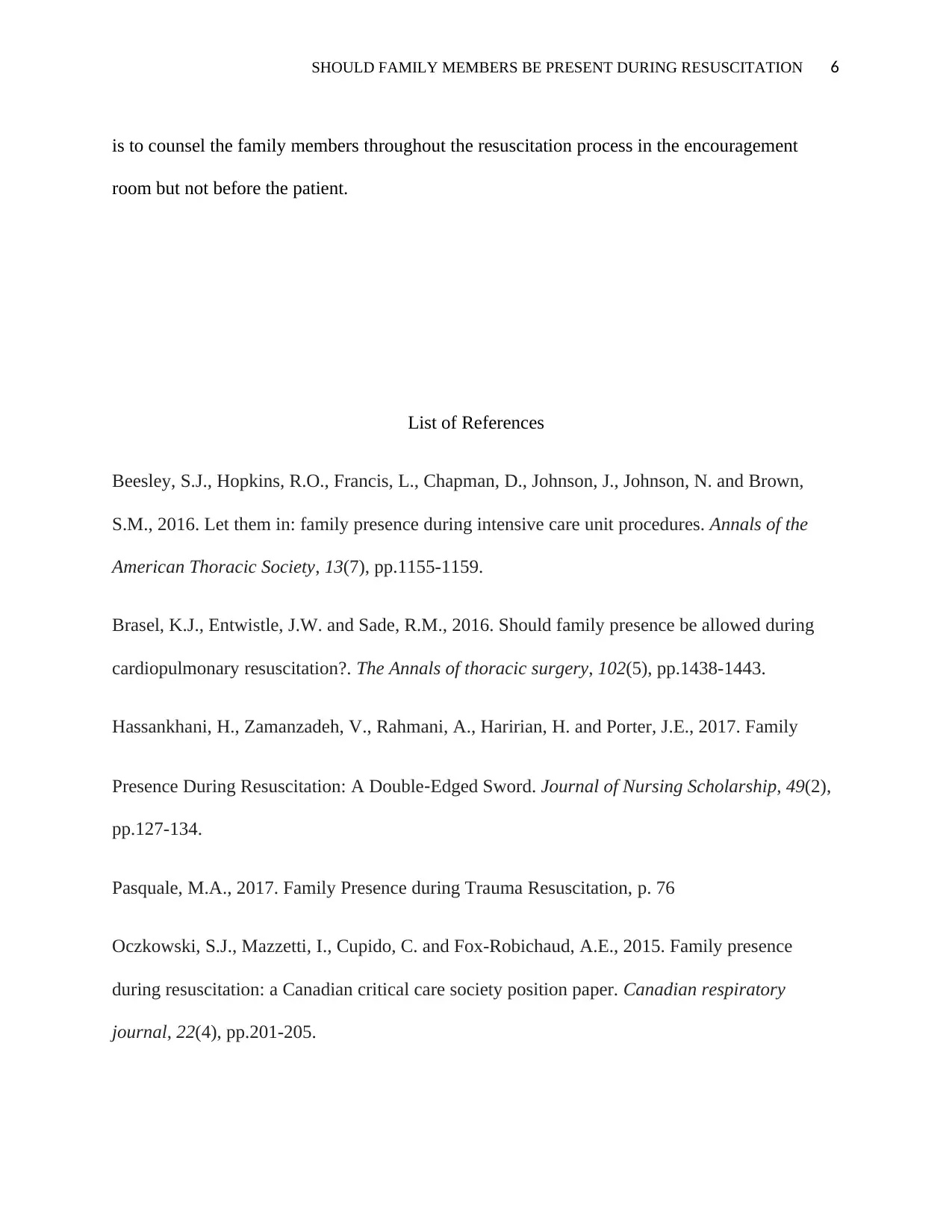
SHOULD FAMILY MEMBERS BE PRESENT DURING RESUSCITATION 6
is to counsel the family members throughout the resuscitation process in the encouragement
room but not before the patient.
List of References
Beesley, S.J., Hopkins, R.O., Francis, L., Chapman, D., Johnson, J., Johnson, N. and Brown,
S.M., 2016. Let them in: family presence during intensive care unit procedures. Annals of the
American Thoracic Society, 13(7), pp.1155-1159.
Brasel, K.J., Entwistle, J.W. and Sade, R.M., 2016. Should family presence be allowed during
cardiopulmonary resuscitation?. The Annals of thoracic surgery, 102(5), pp.1438-1443.
Hassankhani, H., Zamanzadeh, V., Rahmani, A., Haririan, H. and Porter, J.E., 2017. Family
Presence During Resuscitation: A Double‐Edged Sword. Journal of Nursing Scholarship, 49(2),
pp.127-134.
Pasquale, M.A., 2017. Family Presence during Trauma Resuscitation, p. 76
Oczkowski, S.J., Mazzetti, I., Cupido, C. and Fox-Robichaud, A.E., 2015. Family presence
during resuscitation: a Canadian critical care society position paper. Canadian respiratory
journal, 22(4), pp.201-205.
is to counsel the family members throughout the resuscitation process in the encouragement
room but not before the patient.
List of References
Beesley, S.J., Hopkins, R.O., Francis, L., Chapman, D., Johnson, J., Johnson, N. and Brown,
S.M., 2016. Let them in: family presence during intensive care unit procedures. Annals of the
American Thoracic Society, 13(7), pp.1155-1159.
Brasel, K.J., Entwistle, J.W. and Sade, R.M., 2016. Should family presence be allowed during
cardiopulmonary resuscitation?. The Annals of thoracic surgery, 102(5), pp.1438-1443.
Hassankhani, H., Zamanzadeh, V., Rahmani, A., Haririan, H. and Porter, J.E., 2017. Family
Presence During Resuscitation: A Double‐Edged Sword. Journal of Nursing Scholarship, 49(2),
pp.127-134.
Pasquale, M.A., 2017. Family Presence during Trauma Resuscitation, p. 76
Oczkowski, S.J., Mazzetti, I., Cupido, C. and Fox-Robichaud, A.E., 2015. Family presence
during resuscitation: a Canadian critical care society position paper. Canadian respiratory
journal, 22(4), pp.201-205.
⊘ This is a preview!⊘
Do you want full access?
Subscribe today to unlock all pages.

Trusted by 1+ million students worldwide

SHOULD FAMILY MEMBERS BE PRESENT DURING RESUSCITATION 7
Vincent, C. and Lederman, Z., 2017. Family presence during resuscitation: extending ethical
norms from paediatrics to adults. Journal of medical ethics, 43(10), pp.676-678.
Vincent, C. and Lederman, Z., 2017. Family presence during resuscitation: extending ethical
norms from paediatrics to adults. Journal of medical ethics, 43(10), pp.676-678.
1 out of 7
Your All-in-One AI-Powered Toolkit for Academic Success.
+13062052269
info@desklib.com
Available 24*7 on WhatsApp / Email
![[object Object]](/_next/static/media/star-bottom.7253800d.svg)
Unlock your academic potential
Copyright © 2020–2025 A2Z Services. All Rights Reserved. Developed and managed by ZUCOL.


